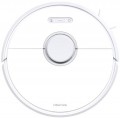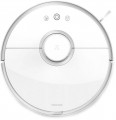Water tank capacity
A capacity of a tank for water or detergent a vacuum cleaner with a wet cleaning function is equipped with. (see "Cleaning type").
Large capacity allows you to work longer without refilling the tank. On the other hand, an increase in capacity has a corresponding effect on the size, weight and cost of the unit. Thus, manufacturers choose this parameter taking into account the general specialization and the “weight category” of a particular model. So, in robots (see "Type"), the volume of the water tank is, by definition, small. Even in the heaviest models, it does not exceed 650 mL. But other types of vacuum cleaners can differ markedly in this parameter.
In general, for non-robot units, a capacity
of 1 liter or less is considered very limited,
1 – 2 liters is small,
2 – 3 liters is average,
more than 3 liters is above average. However, it much depends on the type. For example, in conventional vacuum cleaners, the capacity does not exceed 2.5 liters, and "for workshop" models this is very little — in most cases, they have a tank capacity of 3 liters or more.
Robot features
Additional functions provided in the design of the robot vacuum cleaner (see "Type").
Most often in modern robots you can find such special functions:
scheduled cleaning,
fall protection,
obstacle sensor,
object recognition,
water supply adjustment,
control via the Internet,
remote control and
video surveillance camera. Here is a more detailed description of each of them:
- Scheduled cleaning. The ability to set a schedule according to which the vacuum cleaner will clean automatically, without additional commands from the customer. At the same time, the specific features of such programming may be different, they should be specified separately. So, in the simplest models, the schedule is limited to individual hours within a day - for example, from 16 to 17; at the set hours, the vacuum cleaner is switched on every day. More advanced devices may provide a schedule for the days of the week or even for the dates of the month or year. In any case, this function greatly simplifies the use: it is enough to set the schedule once - and you can not worry about cleaning for at least a few days; especially since most models with this capability also have the function
of docking...(see “Robot Configuration - Charging Station”), and the customer only needs to periodically empty the dust container (which is even more simplified if there is a docking station with a bag - see . below).
- Fall protection. Special protection that prevents the vacuum cleaner from falling off steps, high thresholds, etc. In most cases, the basis of such a system is one or more sensors located on the underside of the case. When the vacuum cleaner travels to the edge of the surface being treated, the sensor reacts to this edge - as a result, the device stops and changes direction in order to avoid falling.
- Obstacle sensor. Sensor (or sensor system) for detecting obstacles in the path of the vacuum cleaner. The specific type of such sensors can be different: ultrasonic, infrared, laser, contact, etc. However, in any case, this function allows the device to move in space, avoiding collisions and determining the best detour path. Note that models without such a sensor, for the most part, are also able to bypass obstacles - however, for this, the robot must not only stumble upon a foreign object, but try to pass through it. And only in case of failure, the trajectory changes - moreover, randomly, far from always in the optimal (or at least suitable) direction.
- Object recognition. The function of recognizing various objects on the floor that may interfere with the cleaning process. It is implemented through the presence of a front camera to adjust the optimal route for the vacuum cleaner along the perimeter of the serviced area. The camera in the design of the robotic cleaner reads the outlines of objects and allows you to bypass such obstacles. As a result, slippers, socks thrown under the bed, children's's toys and wires will no longer interfere with the movements of the vacuum cleaner. The function is of particular benefit in the presence of pets at home that are not accustomed to the tray - the robot will calmly has their waste products and keep the nervous system of pet owners healthy.
— Adjustment of water supply. Dosing system for the degree of wetting of the washing cloth in automatic mode. The ability to select the intensity of the water supply allows you to adjust the operation of the robotic vacuum cleaner for different types of floor coverings. For example, for parquet and laminate, the customer can set a low water flow rate, and for less whimsical tiled flooring, a high water flow rate. Also, the vacuum cleaner can turn off the water supply to avoid leaks, for example, when charging. In advanced models of robotic vacuum cleaners, the function of choosing an individual degree of wetting of the napkin for each of the rooms of the dwelling is often incorporated.
— Docking station with a bag. Docking station with its own trash bag. Upon arrival at such a stand, the robot can not only recharge the battery, but also carry out self-cleaning - unload the collected garbage into an external container; The capacity of the dock, as a rule, is enough for several unloadings. The convenience of this function is obvious: it allows the device to work longer without customer intervention, eliminates the need to manually clean the vacuum cleaner when the dust container is full (besides, unloading garbage from the dock is usually easier than such cleaning). True, and such opportunities are quite expensive.
- Management from the Internet. The ability to control the vacuum cleaner via the Internet - most often through a special application on a smartphone or other gadget (theoretically, such control is also possible through a web page that opens in any browser, but in practice this method is almost never used). The robot itself is connected to the network via Wi-Fi. The main advantage of this function is obvious - it allows you to give commands to the device from anywhere in the world where there is Internet access. In this way, for example, you can start a cleaning programme the day before you return from vacation in order to return to a freshly cleaned apartment. And the vacuum cleaner, in turn, can send various notifications to the customer - about the state of the battery, the progress of cleaning, the fullness of the dust container, etc.
- Remote control. A classic remote control that allows you to give commands to the device from a distance. As a rule, such a remote control covers all the main functions of the vacuum cleaner, and in many models it also allows you to directly control the movement. In any case, without remote access, it would be very difficult to control a moving vacuum cleaner - you would either have to wait until it finishes working, or catch the unit on the go. In light of this, this feature is very popular; however, on sale you can find a lot of robots without a remote control. As a rule, these are either the simplest budget devices with a random movement mode and without any additional functions, or advanced models where a smartphone / tablet with an application is used for control.
We also note that the remote controls in robotic vacuum cleaners usually work via an infrared channel - similar to remote controls for TVs, air conditioners, etc. Thus, to receive a command, the vacuum cleaner must be in the line of sight. However, in most cases this can not be called a serious inconvenience.
- Videcam. Own surveillance camera built right into the vacuum cleaner. This feature is only found on web-based models (see above); it allows you to use the robot as a remote video surveillance system and control the situation in the room, being outside and watching the picture from the camera on the smartphone screen. Also, the built-in camera can be used in the mapping system (see "Building a room map") - however, we note that not every vacuum cleaner with a built-in mapping camera has a video surveillance function.Charging time
The time required to charge the cordless vacuum cleaner fully (see "Power supply").
Larger batteries tend to take longer to charge. On the other hand, modern batteries can use various solutions that speed up the process, so there is no strict dependence here.
Separately, we note that the speed of charging batteries is usually uneven: at first, the process is fast, then it gradually slows down. So if, for example, the specifications indicate a charging time of 2 hours, then charging from 0 to 50% will take a little less than an hour, and from 50% to 100% the remaining time.
Noise level
The noise level produced by the vacuum cleaner during operation. Usually, the value for normal operation at maximum engine power is indicated here. With less power, the loudness of the unit may be lower, but the key is precisely the maximum indicator.
Regarding specific numbers, keep in mind that the decibel used to measure the noise level is a non-linear quantity. Therefore, it is worth evaluating specific indicators using special comparative tables. In general, vacuum cleaners are quite noisy appliances; so in this case, models are considered quiet if this indicator
does not exceed 65 dB — this is the level of a loud conversation between 2 – 3 people at a distance of 1 m. The quietest of these models give out only 40 dB — this is the average volume of a person’s speech in normal tones (and the minimum volume allowed for constant noise sources in living quarters during the day). For louder units, the comparison table looks like this:
—
66 – 70 dB — loud conversations between several groups of people at a distance of about 1 m;
—
71 – 75 dB — the volume of a cry or laughter in full voice at a distance of about 1 m;
—
76 – 80 dB — the volume of a mechanical alarm clock or the engine of an old truck;
—
more than 80 dB — a very high noise level, exceeding the level of a loud scr
...eam; when working with a vacuum cleaner having such specifications for a long time, it is highly desirable to use hearing protection.
Also note that the noise level largely depends on the engine power, as well as some other features (for example, it is strongly affected by the presence of an aquafilter — see "Dust collector"). At the same time, there is no hard connection here, and units with a similar set of specifications can differ markedly in actual loudness. In such cases, when choosing here, it is worth proceeding from the fact that a quieter vacuum cleaner will be more comfortable to use. However, it will most likely cost noticeably more.
